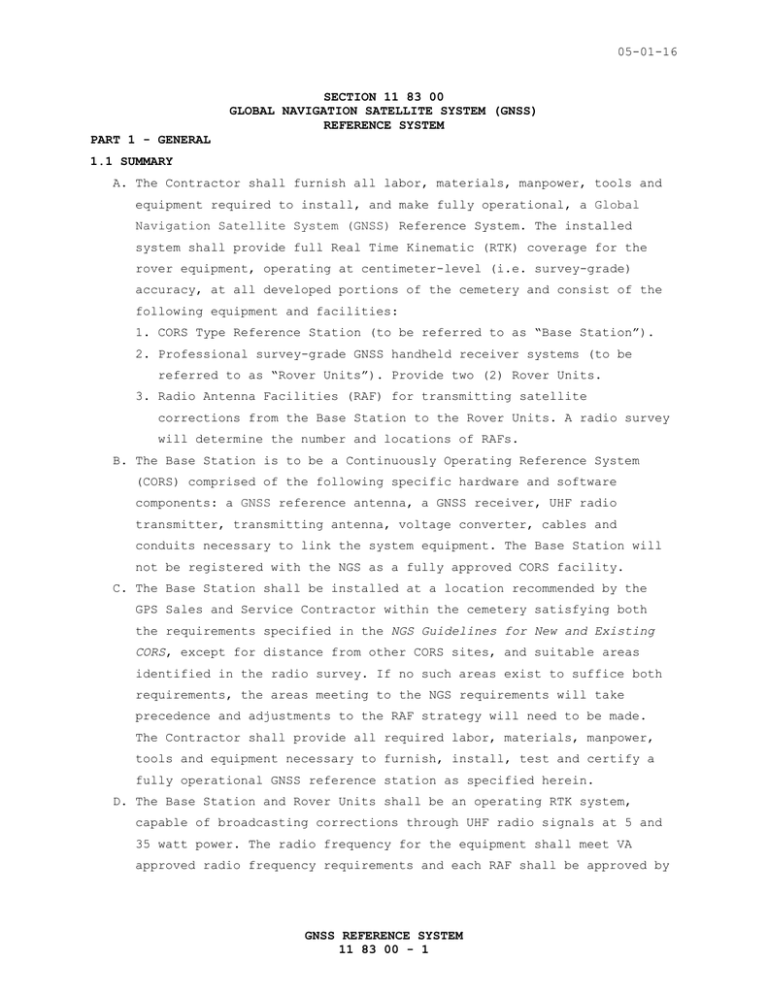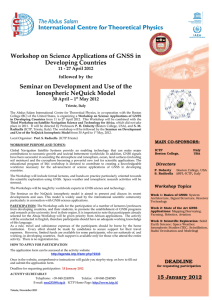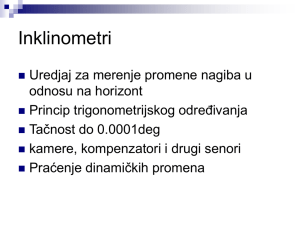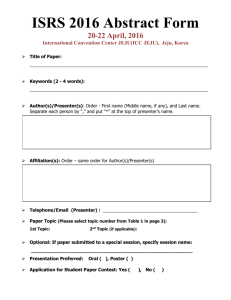05-01-16 A. The Contractor shall furnish all labor, materials, manpower, tools... equipment required to install, and make fully operational, a
advertisement

05-01-16 SECTION 11 83 00 GLOBAL NAVIGATION SATELLITE SYSTEM (GNSS) REFERENCE SYSTEM PART 1 - GENERAL 1.1 SUMMARY A. The Contractor shall furnish all labor, materials, manpower, tools and equipment required to install, and make fully operational, a Global Navigation Satellite System (GNSS) Reference System. The installed system shall provide full Real Time Kinematic (RTK) coverage for the rover equipment, operating at centimeter-level (i.e. survey-grade) accuracy, at all developed portions of the cemetery and consist of the following equipment and facilities: 1. CORS Type Reference Station (to be referred to as “Base Station”). 2. Professional survey-grade GNSS handheld receiver systems (to be referred to as “Rover Units”). Provide two (2) Rover Units. 3. Radio Antenna Facilities (RAF) for transmitting satellite corrections from the Base Station to the Rover Units. A radio survey will determine the number and locations of RAFs. B. The Base Station is to be a Continuously Operating Reference System (CORS) comprised of the following specific hardware and software components: a GNSS reference antenna, a GNSS receiver, UHF radio transmitter, transmitting antenna, voltage converter, cables and conduits necessary to link the system equipment. The Base Station will not be registered with the NGS as a fully approved CORS facility. C. The Base Station shall be installed at a location recommended by the GPS Sales and Service Contractor within the cemetery satisfying both the requirements specified in the NGS Guidelines for New and Existing CORS, except for distance from other CORS sites, and suitable areas identified in the radio survey. If no such areas exist to suffice both requirements, the areas meeting to the NGS requirements will take precedence and adjustments to the RAF strategy will need to be made. The Contractor shall provide all required labor, materials, manpower, tools and equipment necessary to furnish, install, test and certify a fully operational GNSS reference station as specified herein. D. The Base Station and Rover Units shall be an operating RTK system, capable of broadcasting corrections through UHF radio signals at 5 and 35 watt power. The radio frequency for the equipment shall meet VA approved radio frequency requirements and each RAF shall be approved by GNSS REFERENCE SYSTEM 11 83 00 - 1 05-01-16 the VA Radio Frequency Spectrum Management Office for the system to be considered fully operational. E. The GNSS receiver shall be capable of utilizing Global Positioning System (GPS), Modernized GPS, and GLONASS satellite signals. The system shall be capable of code and phase measurements, internal raw data logging, raw data streaming, and have internal data storage capabilities. F. All field data collected by the Rover Units shall meet or exceed 1 centimeter accuracy standards as defined by the Federal Geographic Data Committee, Draft Geospatial Positioning Accuracy Standards, Part 2, Standards for Geodetic Networks. G. There will be at least one (1) RAF but more may be required depending on the result of a radio survey. The selected antenna location(s) shall be established in areas where respective signals combined produce full coverage for all developed areas of the cemetery. The antenna location(s) shall be confirmed and adjusted, as required, following the Contractor provided radio survey (if the survey hasn't been completed before bidding). The radio survey will be conducted with “leaves on” and used to determine suitable locations and elevations for each RAF. One RAF location shall be within a 200 foot cable run (signal booster is required for longer cable runs when necessary, as recommended by the equipment provider) from the Base Station. Additional antenna locations, as needed to provide complete coverage, shall function as radio repeater stations. If the radio survey determines that the location for one or more of the antennas needs to be on top of an existing building, then the mounting options, as recommended by the manufacturer, will be evaluated by the RE/COR and A/E. All final antenna locations shall be approved by the RE/COR and A/E, acceptable to the GPS equipment supplier/installer, and selected from within the areas determined suitable during the radio survey; taking into consideration the mounting of each antenna and the aesthetics of the mounted location. H. Any appurtenant work required to make the system fully functional shall be provided, including but not limited to furnishing and installing all required labor, materials, tools and equipment. The completed work shall be performed as much as possible to hide the equipment, conduit, wiring, mounting hardware, etc. and shall include restoration and/or repair of any disturbed materials and facilities to pre-work GNSS REFERENCE SYSTEM 11 83 00 - 2 05-01-16 conditions. This appurtenant work shall also include: calibrating and testing all other required facilities and equipment to make the GNSS Reference System fully functional as described herein, including work that is covered in other specifications sections or indicated on the contract drawings. I. The Contractor shall provide training for the cemetery staff on the use and maintenance of all equipment, components, and software. This training shall be video recorded and made into a DVD for future use by the VA, and the Contractor shall provide O&M Manuals for all equipment. The O&M Manuals shall include specific procedures for operation of equipment provided under this contract and shall include photographs of equipment provided for this project. 1.2 RELATED WORK A. See Section: 32 12 16 Asphalt Paving B. See Section: 03 30 00 Cast-in-Place Concrete C. See Section: 32 05 23 Cement and Concrete Work for Exterior Improvements D. See Section: 26 05 33 Raceway and Electrical Boxes E. See Section: 31 20 00 Earth Moving F. See Section: 11 83 01 Geographic Information System (GIS) G. See Section: 11 83 02 GNSS & GIS Mapping and GeoData 1.3 REFERENCES A. The entire installation shall comply with all local and state laws and ordinances, and with all established codes applicable thereto. B. In all cases where the specifications require that the work be performed under the direction and/or inspection of the Resident Engineer, notify the Resident Engineer at least 24 hours in advance of the time when such inspection and/or direction is required. Any alterations to the system needed because of the Contractor's failure to have the required inspections shall be performed at the Contractor's expense. C. National Geodetic Survey, Guidelines for New and Existing Continually Operating Reference Stations (CORS), January 2013. D. Federal Geographic Data Committee, Draft Geospatial Positioning Accuracy Standards, Part 2, Standards for Geodetic Networks - FGDC-STD007.2-1998. E. US Army Corp of Engineers EM 1110-1-1002 Survey Markers and Monumentation. GNSS REFERENCE SYSTEM 11 83 00 - 3 05-01-16 1.4 SUBMITTALS A. Provide manufacturer’s literature and specifications of system components for review by RE/COR and A/E. B. Submit in accordance with Section 01 33 23, SHOP DRAWINGS, PRODUCT DATA AND SAMPLES. Complete shop and installation drawings of all GNSS system components, showing dimensions and details of construction, installation and relation to adjoining work, reinforcements, anchorages, attachments, location of all conduit and other items to be installed in the work of other trades, joint treatment, and other work required for a complete installation. C. Provide product information, O&M manuals and any additional paperwork associated with each system component, individually tabbed for ease in location, and the entire system in triplicate in separate three-ring binders for Government records. Provide a photo documented record of the installation, with each pieces of equipment identified and referenced to the applicable tabbed location in the three-ring binders. Include in the Appendix a list of all devices with their make, model, and serial number. D. Include in the O&M manual a troubleshooting list of items to check in the event of problems with the normal operation of the equipment, or system failure. The equipment in the troubleshooting list shall also be photo documented with the actual equipment installed for this project. Provide the owner with a step by step guide of operational checks to try and fix problems, prior to calling technical support. 1.5 QUALITY CONTROL A. Have a competent superintendent satisfactory to the Resident Engineer, with authority to act in all matters pertaining to the installation of the project work, present on the project site during all installation activities. B. Coordinate all work with other site contractors and the RE. C. The Base Station installation, including the calibration, startup, testing, and all activities needed to make the station fully functional and operational with the rover units, as well as transferring information to and from the GIS system, shall be coordinated with the GPS equipment supplier and the GIS contractor for this project. The Contractor shall insure that appropriate quality control is provided throughout the construction process, up to the turn-over of the fully functional GNSS reference system for this project, as required to GNSS REFERENCE SYSTEM 11 83 00 - 4 05-01-16 insure that the end result meets the performance specifications for the GNSS reference system being provided. 1.6 SITE CONDITIONS A. Submission of an executed proposal shall be considered evidence that the site, plans and specifications as issued, and/or legally modified, have been examined and accepted. B. Report to the Resident Engineer any deviations between contract documents and actual conditions. Failure to do so prior to the installation of equipment and which results in the replacement and/or relocation of equipment shall be at the Contractor's expense. C. The exact location of all new and existing utilities and structures may not be indicated on the drawings; their locations shall be field verified by the Contractor prior to starting work, and installation of work shall proceed so as to prevent interruption of service or damage to them. Protect existing structures and utility services and replace, at no cost to the Government, if damaged. Where conflicts occur, notify the Resident Engineer of any relocation required to complete the work of this contract. 1.7 GUARANTEE A. The furnished and installed operational GNSS reference system shall be capable of providing Real Time Kinematic (RTK) corrections for the roving GNSS handheld receivers as described herein. B. Contractor shall demonstrate complete site coverage radio operation for Real Time Kinematic (RTK) system operation prior to VA acceptance of installation. The system components shall be guaranteed as operational in every detail, except for power interruption, for a period of five (5) years from the date of its acceptance. Provide any required labor, manpower, tools, materials and equipment required to repair and/or replace any contractor provided elements of the functional GNSS reference system within that five year period with no cost to the owner. 1.8 ACCEPTANCE A. Acceptance of the CORS Base Station facilities and the Rover Units will result only when the installed system has been demonstrated to function as specified herein. The acceptance of the above systems shall require approval of the radio broadcast frequency by the VA Radio Frequency Spectrum Management Office, demonstration that data collection using GNSS REFERENCE SYSTEM 11 83 00 - 5 05-01-16 the Rover Units as described in the contract documents can be achieved, and the data is easily downloaded to the GIS computer as specified in Section 11 83 01 Geographic Information System (GIS). Prior to requesting final inspection of equipment, contact the Resident Engineer to review installation of hardware, software, cable and conduit runs, demonstrate the functionality of the equipment, and schedule staff training. B. The training for the use of the system equipment shall be performed after final acceptance of the training materials by the RE/COR and when the equipment can be utilized with the GIS system, so the staff can use both systems as they will be during the operation of the Cemetery after the construction project is completed. The training program shall not be considered complete until after the O&M Manual has been submitted and approved in its final form. PART 2 - MATERIALS 2.1 GNSS REFERENCE SYSTEM EQUIPMENT A. All equipment and accessories will be brand new, unused, and not reconditioned, remanufactured, nor recertified. B. GNSS Receiver for Base Station Hardware and Software shall be from a single manufacturer. Basis of design is the Trimble NetR9 Ti-1 Reference Station w/Zephyr Antenna or approved equal. 1. GNSS Receiver shall process multi-bit analog-to-digital conversion and Surface Acoustic Wave (SAW) filter at both RF and IF frequencies to provide anti-spoofing performance. 2. The GNSS Receiver shall, after the loss of satellite signals, provide re-acquisition of both L1 and L2 signals within 15 seconds. 3. Electronics shall be 100% fully sealed from sand, dust, and moisture. 4. Shall be able to operate to measurement specification in temperatures between -40 degrees F to +149 degrees F. 5. Shall not be less than 100% condensing humidity proof. 6. Connectors shall fully seal the receiver when a like-connector is attached. 7. Power requirements shall be in the range of 9.5 V DC to 28V DC external power input with over-voltage protection. 8. The GNSS Receiver shall support simultaneous signal tracking of all: a. GPS: L1C/A, L2C, L2E, L5 GNSS REFERENCE SYSTEM 11 83 00 - 6 05-01-16 b. GLONASS: L1C/A, L2C/A, L3CDMA c. SBAS: L1C/A, L5 d. Galileo L1CBOC, E5A, E5B, E5AltBOC 9. When Anti-Spoofing (A/S) (P-code) is activated, the GNSS Receiver shall measure L1 C/A pseudo ranges, L2 and L5 range measurements, and the full cycle L1, L2 and L5 carrier phases. 10. The GNSS receiver shall contain a high-precision multiple correlator for L1, L2 and L5 pseudo-range measurements. 11. Performance of receiver shall not be lower during times when antispoofing is activated, compared to during times when anti-spoofing is not activated. 12. The GNSS receiver shall employ multipath mitigation techniques. 13. All damaged or rejected materials due to defect or non-conformance shall be removed from the site. C. Radio Transmitter for Base Station Basis of design is the Trimble TDL 450H Radio or approved equal. 1. Radio to transmit the satellite corrections from the base station shall be of the same manufacturer as the Base Station GNSS receiver. 2. All radio equipment must be able to broadcast in the 406 MHz to 420 MHz frequency range. 3. All radio equipment shall be dustproof. 4. Radio must be able to withstand operating temperatures of -40 degrees F to +149 degrees F. D. Antenna Mount and Support Hardware 1. Roof-based mounting is the preferred mounting choice and should be used when mounting options conforming to NGS roof-based monument guidelines are available. Should the roof-based mounting option not be available then reinforced concrete pier foundation shall be installed per drawings at the location specified on contract drawings. 2. All necessary hardware, conduits, junction boxes and fittings required for a complete and functional system in accordance with manufacturer’s recommendations and NGS CORS guidelines shall be provided. 3. Roof-based mounts shall be made of stainless steel and mounted per NGS CORS guidelines to the building. Ground-based mounting will use Earl Conic eight (8) foot stainless steel mast, with a four place reinforced gusset system along the lower four (4) feet of the mast. GNSS REFERENCE SYSTEM 11 83 00 - 7 05-01-16 All hardware for fastening the mast to the foundation shall be included and be specified according to manufacturer. 4. A NGS approved leveling & orientating device is to be used to mount the GNSS Antenna to the monument. E. GNSS Antenna Basis of design is the Trimble Zephyr Geodetic 2 GNSS Antenna or approved equal. 1. GNSS antenna shall be of the same manufacturer as the base station receiver and capable of receiving all satellite signals the base station receiver is required to track. 2. Quality signal tracking, even below 5 degrees elevation. 3. Four point antenna feed for phase center stability and enhanced polarization. 4. Small cross-sectional area to reduce wind loading. 5. 13 dB amplifier margin supports cable runs of over 60 m without special coaxial cable on in-line amplifiers. 6. North orientation marking on exterior. 7. 50 dB signal gain for reliable tracking in difficult environments. 8. Low voltage, low power consumption. 9. Integral low noise amplifier. 10. 5/8” x 11 female threaded stainless steel mount point. 11. Powered by GNSS receiver via coaxial cable. 12. Advanced LNA (low noise amplifier) to reduce jamming by high power out-of-band transmitters. 13. Stealth Ground Plane – integrated lightweight stealth technology with enhanced right hand 14. 100% humidity proof and fully sealed. 15. Meets MIL-STD-810-F to survive a 2 meter drop onto concrete. 16. Operating temperature (-40 to +158 degrees F) F. Handheld GNSS Receivers and Data Loggers (two required) Basis of design is the Trimble PROD R8/5800 Rover Kit; Base – Base & Rover Transport Case (5800 and R8); Ant Portable 6” Whip 406-430MHZ or approved equal. 1. Each Rover Unit (mobile GNSS receiver and data logger combination) shall receive correction signals from the on-site Base Station, via a built-in radio receiver, and provide real time positional accuracies within the manufacturer’s published horizontal and vertical positioning accuracy on all parts of the property. GNSS REFERENCE SYSTEM 11 83 00 - 8 05-01-16 2. The GNSS antenna for the rover shall be able to track the following satellite signals: a. GPS: L1C/A, L2C, L2E, L5 b. GLONASS: L1C/A, L2C/A, L3CDMA 3. The GNSS antenna for the rover shall be of the same manufacturer as the Base Station receiver. 4. The horizontal accuracy classification shall be a one (1) centimeter horizontal accuracy at the 95-percent confidence interval. 5. The rover will have an integrated camera with an integrated flash, autofocus, at least 5 megapixels, and can tie photographs to the captured position. 6. All rover components shall use a rechargeable and removable battery. Extra batteries to provide full day of use shall be provided for each component. 7. Data logger and GNSS receiver shall connect via integrated Bluetooth to remove the need for cables. The option for Bluetooth discoverability by devices other than rover components shall be disabled. 8. All rover components shall meet or exceed IP65 rating. 9. Rover GNSS receivers shall be able to withstand a 2 meter drop onto concrete. 10. Rover data loggers shall be able to withstand a 1.22 meter drop onto concrete. 11. All rover components shall have an operating temperature range of at least -4 degrees F to +122 degrees F. 12. The system shall include a ruggedized carry case for each rover that both protects the rover and provides storage while in the field. 13. An accessory kit with a 2 meter carbon fiber snap-lock rover pole, with thumb-release bipod, pole storage bags, alternate rubber foot pads or spike caps for all pole legs, and a data logger mount shall be included for each rover. 14. Rovers shall be loaded with the latest version of ESRI ArcGIS Mobile for Windows. 2.2 SYSTEM CONTROL BOX A. General 1. The base station receiver and radio shall be installed in a rack enclosure storage cabinet, similar to the Tripplite SRW6u Wall Mount Rack Enclosure. The control box shall be mounted in the selected GNSS REFERENCE SYSTEM 11 83 00 - 9 05-01-16 location, shall have a painted 1” thick panel board mounted inside of the control box for mounting the equipment. Inside of the control box shall be an uninterrupted power supply (UPS) capable of providing 30 minutes or more of power to the GNSS receiver and radio. The size of the control box shall be no larger than 3 feet wide by 3 feet high, by 2 feet deep. It shall include a locking door. 2. The control box shall provide a secure location for equipment placement and ventilation for continuous system operation. 3. All connections to hardware shall be made in accordance to component manufacturer specifications, including length of cable, type of cable and connection types. No modifications to cables, connections or installation shall be made that would void component manufacturer warranties. 4. Technical instructions on troubleshooting the system and restarting after power failure, shall be created and installed by the Contractor on the inside door of system control box. 2.3 CABLE AND CONDUIT CONNECTIONS A. Design basis for cable shall be the Times Microwave LMR 600 Flooded DB (direct bury) coaxial cable, or approved equivalent. B. Furnish and install antenna signal amplifier as indicated on drawings. Basis of design is Model LA20RPDC by GPS Networking Inc.(Denver CO). C. See Section 26 05 33, RACEWAY AND BOXES FOR ELECTRICAL SYSTEMS, for conduit specifications. D. Provide grounding and lightning protection as shown on contract drawings. 2.4 REFERENCE MONUMENTS A. General 1. Five (5) concrete monuments shall be installed being a minimum 3.5 inches in diameter, with a 1/2 inch minimum metallic rod centered within the concrete, running the length of the monument. The monuments shall be a minimum 3 feet in length. 2. Monument locations shall be installed in a stable surface that is not subject to effects of geologic and soil activity in the region, in accordance with contract drawings and reference provided in paragraph 1.3. Monuments must be highly visible away from vegetation, floodplain, or man-made structures that are subject to movements, etc. GNSS REFERENCE SYSTEM 11 83 00 - 10 05-01-16 3. The Contractor shall submit a map of permanent survey markers installed with the applicable coordinates along with temporary benchmarks (i.e. PK nails, etc.) required by this contract. 2.5 INTEGRATION WITH THE GEOGRAPHIC INFORMATION SYSTEM (GIS) EQUIPMENT A. The Rover Units shall have software installed and configured to facilitate the collection of data, collection of digital photographs, transfer of data into the GIS, and transfer information from the GIS equipment to the Rover Units to stake out features via the display. PART 3 - EXECUTION 3.1 SITE CALIBRATION AND QUALITY CONTROL A. Static satellite observations shall be made on all five (5) reference monuments, with a minimum of two (2) hours of static data being collected on each monument, with a geodetic grade GNSS receiver. B. Static observations shall be collected on the GNSS Reference Station simultaneous to all reference monuments being observed, to ensure simultaneous data is collected on both the reference station and all reference monuments for final evaluation and approval of adjusted coordinates. C. All static observations shall be submitted to the National Geodetic Survey (NGS) Online Positioning User Service (OPUS) for calculation of state plane coordinates, using the State Plane Coordinate System. D. Adjusted coordinate values as obtained from the NGS OPUS adjustment shall be used as record coordinates for the CORS Reference Station and on any future data collection of stakeout of site facilities. E. The Contractor shall install the record coordinates in the CORS Reference Station firmware, and initiate broadcast signals. All reference monuments shall be navigated to using the record coordinates obtained from OPUS. The residual error shall be noted by the Contractor and certified to be within tolerances set forth in specification documents. F. A/E shall provide CAD files to the Contractor at NTP for use in building the GIS maps. The Contractor shall populate the maps with geodata per geospatial standards as work progresses. The early turn over area and features must be added to the GIS prior to transferring the area to the cemetery so the cemetery may start tracking interments and populating the GIS database. - - - E N D - - - GNSS REFERENCE SYSTEM 11 83 00 - 11






